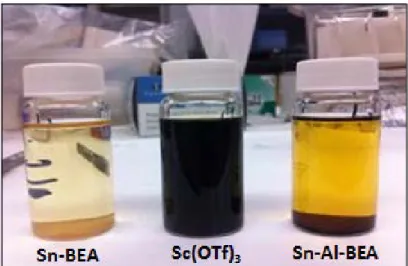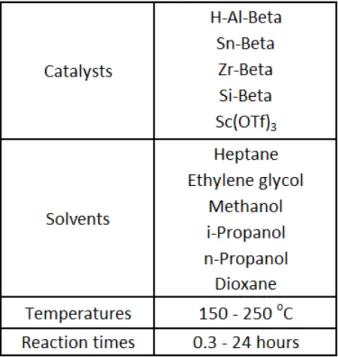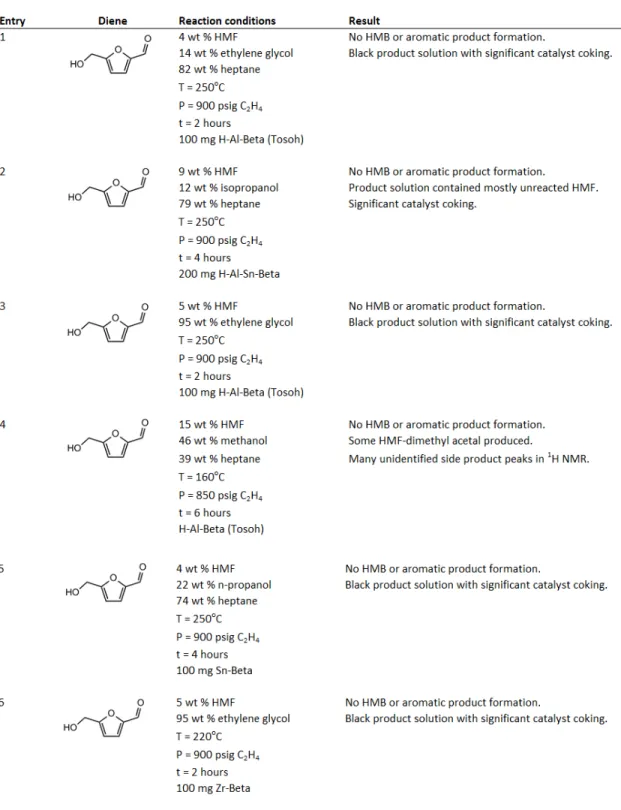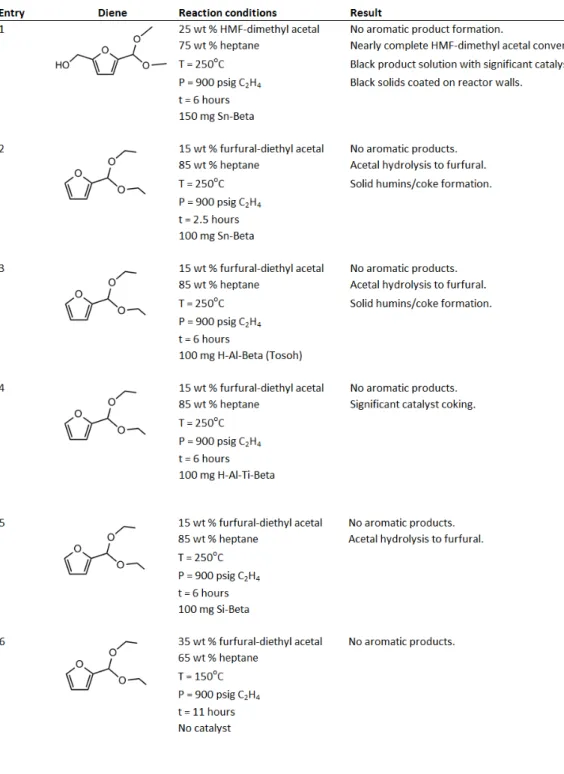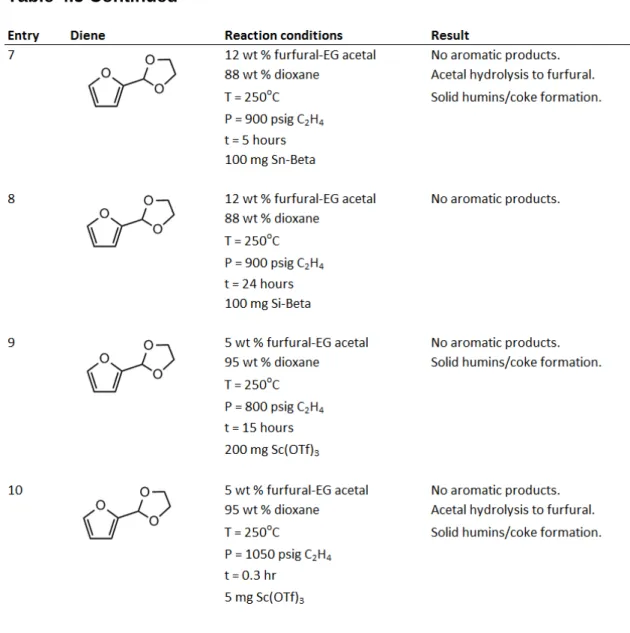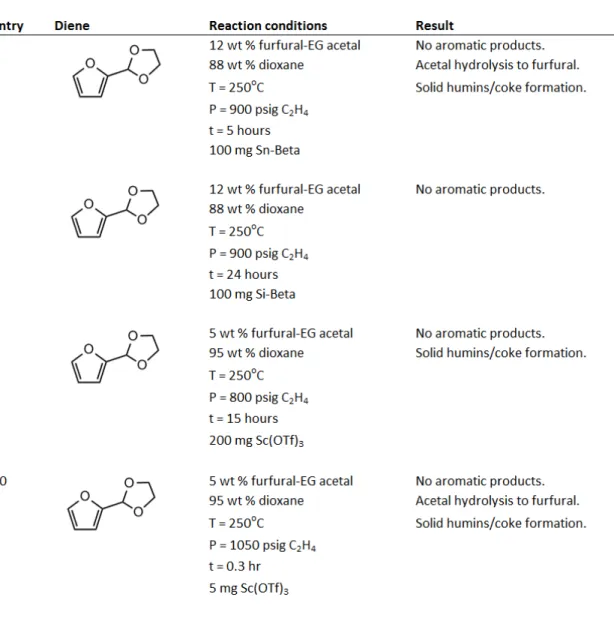CHAPTER 4
USING ETHYLENE AS A DIENOPHILE IN DIELS-ALDER-DEHYDRATION REACTIONS WITH VARIOUS FURANS: SUMMARY OF EXPLORATORY
WORK
Results from reaction screening studies involving ethylene and various furanic dienes, with the objective of finding novel Diels-Alder-dehydration reactions that would allow for an oxidation route from HMF to PTA, are
summarized in this chapter. The known DMF to PX conversion was investigated and will be discussed first. The use of HMF, protected derivatives of HMF, and FDCA (fully oxidized HMF) as dienes in the ethylene Diels-Alder-dehydration reaction will also be summarized and discussed.
4.1 Conversion of DMF and ethylene to p-Xylene
Here, the conversion of DMF and ethylene to p-xylene was investigated.
Since this reaction has been previously reported to be catalyzed by Bronsted acid zeolites1-8 and homogeneous Lewis acids,9 some of these reports have been reproduced and, in addition, the DMF/PX reaction was used as an initial screening reaction for using the proposed Lewis acid molecular sieves as Diels- Alder-dehydration catalysts.
The main objectives of the work included:
• Reproduce results from previous reports using Bronsted acid zeolites and
homogeneous Lewis acids for the conversion of DMF to p-xylene.
• Determine if heterogeneous Lewis acid molecular sieves (e.g., Sn-BEA, Zr-BEA, Sn-MFI) are catalysts for this reaction.
Bronsted acid-containing zeolites, H-Al-BEA (Tosoh Corp.) and H-Al-Sn- BEA, a homogeneous Lewis acid, scandium triflate [Sc(OTf)3], and pure Lewis acid Beta molecular sieves, Sn-BEA and Zr-BEA, were tested and the results are summarized in Table 4.1. Heptane was chosen as the reaction solvent for
experiments using the Bronsted acid-containing zeolites since previous studies found the aliphatic solvent to give higher PX selectivities. Dioxane solvent was used when testing Sc(OTf)3 since this was reported to be a preferable solvent when using the homogeneous Lewis acid catalysts.9 Little effort was made to optimize the reaction systems for maximum p-xylene yield since the objective
was to screen the various catalysts for p-xylene production from DMF and ethylene.
Table 4.1 Reaction results for PX synthesis via Diels-Alder-dehydration of DMF and ethylene. Reaction temperature = 250oC.
The H-Al-BEA and H-Al-Sn-BEA catalysts made PX at 30 % and 22 % yields, respectively, after 6 hours of reaction time with about 70 % selectivity.
Scandium triflate in dioxane produced PX at 65 % yield with similar selectivity (66
%). These results are in agreement with previous reports that these materials are active in catalyzing PX production. In addition, Table 4.1 shows that Sn-BEA and Zr-BEA were also able to successfully produce p-xylene with 21 % and 6 % yield, respectively, although the selectivity was lower (20-47 %) than the Bronsted acid zeolites and homogeneous Lewis acid. This is the first example of the Lewis acid Beta molecular sieves, Sn-BEA and Zr-BEA, used as catalysts to perform the Diels-Alder-dehydration reaction between DMF and ethylene.
An interesting observation from using the Lewis acid Beta molecular sieve catalysts was that the reaction product mixtures using these materials appeared
“cleaner” after reaction compared to the solutions that were generated using the
H-Al-BEA, H-Al-Sn-BEA, and Sc(OTf)3. Fig. 4.1 shows the product mixtures produced using each of the different catalysts. The conditions for each experiment are summarized in Table 4.2.
There are differences in the color of the solid catalyst between the left (Sn- BEA) and right (H-Al-Sn-BEA) vials. Under these conditions, the aluminum present in the BEA zeolite causes blackening of the solid while the pure Sn-BEA is only slightly discolored. Similarly, the liquid phase becomes more discolored when using the H-Al-Sn-BEA zeolite compared to the Sn-BEA. The scandium triflate catalyst produces a dark brown and opaque solution.
Fig. 4.1 Product solutions using Sn-BEA (left), Sc(OTf)3 (center), and Sn-Al-BEA (right) catalysts. Reaction conditions are given in Table 4.2.
Table 4.2 Reaction results for PX synthesis via Diels-Alder-dehydration of DMF and ethylene using Sn-BEA, Sc(OTf)3, and Sn-Al-BEA catalysts.
Although each of the three product solutions were not further analyzed to better understand each reaction system (e.g., the number of side reactions, organic deposition onto catalyst), the simple observations made at this point from comparing the color of the solutions and catalyst after reaction may suggest that certain side reactions (polymerizations, insoluble solids formation, catalyst coking, etc.) are avoided with the pure Lewis acidic molecular sieves, even though the measured selectivities in Table 4.1 for these materials were lower.
This encouraged further testing of these materials as catalysts for the Diels- Alder-dehydration reaction of other furanic dienes with additional functionality (HMF, FDCA, etc.).
4.2 Conversion of 5-hydroxymethyl furfural (HMF) and ethylene to 4- hydroxymethyl benzaldehyde (HMB)
This section provides the results and discussion for the experiments aimed at finding reaction conditions for performing the Diels-Alder-dehydration reaction (Fig. 4.2) between HMF and ethylene to product the PTA precursor, 4- hydroxymethyl benzaldehyde (HMB). Since the product, HMB, can be oxidized to form PTA, this reaction pathway would allow for a novel oxidation route to PTA from HMF.
Fig. 4.2 Diels-Alder-dehydration of HMF and ethylene to form HMB.
The aldehyde functionality on HMF was a concern for two reasons. First, the aldehyde group was expected to react readily in undesired side reactions at the conditions required for the Diels-Alder reaction with ethylene. Second, the aldehyde group is electron withdrawing and is predicted to deactivate the diene functionality towards cycloadditions, making the reaction with ethylene very slow.
A strategy proposed to improve the reactivity of the furan in the Diels- Alder step while removing the aldehyde group was to “protect” HMF by forming the acetal derivative with alcohols or diols (Fig 4.3). This strategy was
investigated by (1) using alcohols (methanol, propanol) or diols (ethylene glycol) in the reaction solvent to perform the acetalization and Diels-Alder-dehydration in
the same reactor, and (2) by using a two step process in which the acetalization and Diels-Alder-dehydration reactions are done in separate reactors.
Fig. 4.3 Converting HMF to acetal before Diels-Alder-dehydration with ethylene.
A variety of reaction conditions were tested by varying solvents, catalysts, reaction temperature, reaction time, and HMF concentration. Table 4.3 provides a summary of the system conditions that were used during the investigation of finding methods for converting HMF to HMB.
Table 4.3 List of solvents, catalysts, reaction temperatures, and reaction times used to investigate the HMF to HMB reaction.
The screening reactions and results are summarized in Tables 4.4 and 4.5. The experiments utilizing alcohols or ethylene glycol in the reaction solvent to perform the acetalization of HMF and the ethylene Diels-Alder-dehydration in the same reactor are given in Table 4.4. Aluminum-containing (Bronsted acid) catalysts were screened (entries 1-4, Table 4.4) since it was expected that both acetalization and Diels-Alder-dehydration reactions would be Bronsted acid catalyzed. Ethylene glycol was added to the reaction solution (entries 1 & 3) to form the acetal, and alcohols (isopropanol, methanol) were also used (entries 2 &
4). Lewis acid Beta molecular sieves were screened in entries 5 & 6. In each case, no aromatic products were observed. When a lower temperature (160oC) was used in entry 4, some HMF-dimethyl acetal was detected along with other unidentified side products. For the other reactions that used temperatures between 220-250 oC, dark product solutions were obtained with significant catalyst coking.
Experiments in which the reactor was initially charged with the acetal to attempt only the ethylene Diels-Alder-dehydration are summarized in Table 4.5.
Most of the entries in Table 4.5 are for experiments that used furfural-derived acetals, since these compounds could be obtained from a commercial vendor (Sigma-Aldrich). It was reasoned that any ethylene Diels-Alder-dehydration reaction conditions found with the furfural-acetal should also be applicable with the HMF-acetal.
Table 4.4 Summary of screening experiments for the acetalization and ethylene Diels-Alder-dehydration of HMF. Results determined by 1H NMR.
Table 4.5 Summary of screening experiments for the ethylene Diels-Alder- dehydration of HMF-acetal and furfural-acetal dienes. Results determined by 1H NMR.
Table 4.5 Continued
The HMF-dimethyl acetal (entry 1, Table 4.5) was tested in heptane solvent with Sn-Beta present, and nearly complete HMF-dimethyl acetal conversion with no aromatic product formation was observed. Instead, significant catalyst coking and black solid formation occurred. For the
experiments using the furfural-acetals, catalyst coking and solid humins/coke formation occurred for all experiments that utilized high temperatures (250oC) or
an acid catalyst. Heavy catalyst coking and solid humins/coke formation was avoided when the acid catalyst was removed (entries 5-6 & 8, Table 4.5).
The main challenges found for using the acetals as substrates to react with ethylene at the high temperature/pressure conditions expected for the Diels- Alder-dehydration reaction to occur was (1) minimizing the hydrolysis reaction of the acetal back to the aldehyde, and (2) minimizing humins or coke formation on the catalyst and reactor walls. Since water is produced in the desired Diels- Alder-dehydration reaction, the hydrolysis of the acetal to the aldehyde is expected to be difficult to avoid. The cause for the significant humins and coke formation was assumed to be the reactive aldeyhde functionality.
Some other general conclusions from this work on converting HMF to HMB include the following:
• HMF and the HMF-acetal derivatives were found to be reactive towards
humins and/or coke formation under the conditions expected for the Diels- Alder-dehydration reaction to occur (T=150-250oC, P=800-1000 PSI, Bronsted or Lewis acid catalysts), and no yield to the target HMB product was observed.
• When zeolite catalysts are used (Bronsted acid or Lewis acid), significant
carbon deposition or coking of the catalyst occurred. Typically several peaks in the 1H NMR spectra were present in addition to HMF or furfural peaks, most of which were unidentified.
• When a homogeneous Lewis acid (scandium triflate) was used, black solid
or humins formation was observed. HMF peaks typically were not present in the liquid-phase 1H NMR spectra, indicating nearly full conversion of the HMF reactant.
4.3 Conversion of 2,5-bis(hydroxymethyl)furan (BHMF) to 1,4- bis(hydroxymethyl)benzene (BHMB)
It is suspected that the aldehyde substituent on HMF is the cause for the high reactivity of HMF towards undesired side reactions, resulting in no HMB formation. The next diene that was investigated was 2,5-bis(hydroxymethyl)furan (BHMF) which is obtained by a partial reduction of HMF. Since BHMF has only hydroxymethyl [-CH2OH] funtions on the furan ring we thought that the number of side reactions available would be less and would allow for a higher chance of achieving the desired Diels-Alder-dehydration product, in this case 1,4-
bis(hydroxymethyl)benzene (BHMB) . The reaction scheme is shown in Fig. 4.4.
This reaction was studied using two different solvent systems – dioxane and acetic acid.
Fig. 4.4 Diels-Alder-dehydration of BHMF and ethylene to BHMB.
a. Dioxane solvent system
The first issue that was addressed with the BHMF/dioxane system was to determine the temperature up to at which BHMF was thermally stable in the absence of a catalyst. Further experimentation using proposed catalysts would be performed below this temperature to minimize side reactions occurring in the
solution phase. A series of four experiments are summarized in Table 4.6 that varied the reaction temperature between 150-300oC and the reaction time between 1-15 hours. It was found that BHMF was stable (did not react) in the dioxane liquid phase at 250oC for at least 15 hours. When the temperature was raised to 300oC the diene began to undergo side reactions, mainly the
dehydroxymethylation of BHMF to form furfuryl alcohol, furan, and formaldehyde as shown in Fig 4.5. Solids and humins also began to form in the reactor at the 300oC temperature.
Table 4.6 Experiment conditions and results for determining temperature that BHMF is thermally stable. Reaction conditions: 0.1 M BHMF in dioxane, 1000 psig C2H4, no catalyst. Results obtained by 1H NMR analysis.
Fig. 4.5 Dehydroxymethylation of BHMF: a significant side reaction.
Based on the results above, proposed catalysts were tested using
temperatures no greater than 250oC. The two catalysts that were studied in the BHMF/dioxane system are (1) scandium triflate and (2) Sn-BEA molecular sieve.
Several attempts were made to finding conditions that scandium triflate was able to achieve yields of the desired Diels-Alder-dehydration product. In all cases, significant degradation of the BHMF diene occurred, producing mainly solid humins and a black, opaque product mixture. It appears that the
homogeneous Lewis acid is very reactive with BHMF towards these degradation reactions under the 150-250oC reaction temperatures and the result was no yield of the aromatic Diels-Alder-dehydration product.
Numerous experiments were also done using the Sn-BEA catalyst in the BHMF/dioxane system (Table 4.7). Initial tests were done at 250oC (entry 1) and it was found that Sn-BEA at this temperature results in significant catalyst coking and dehydroxymethylation of BHMF as observed by formaldehyde and furan formation.
Table 4.7 Experiment conditions and results for BHMF in dioxane solvent with Sn-BEA catalyst. Reaction conditions: Dioxane solvent, Sn-Beta catalyst, 1000 psig C2H4. Results obtained using 1H NMR analysis.
Next, experiments were performed at 150oC with Sn-BEA catalyst (entries 2-4). At these conditions the undesired dehydroxymethylation reaction was significantly slowed, and the BHMF was still present and mostly unconverted after 6 hours of reaction. After 6 hours (entry 3), low amounts of BHMB were detected by 1H NMR (NMR peaks matched that of BHMB product standard). The product solution was a light green color and not black like that observed for the system using scandium triflate. The reaction at 150 oC was allowed to proceed for 42 hours (entry 4) and BHMB was still observed in the product 1H NMR spectrum while the BHMF peaks were gone indicating complete conversion.
To provide further support that the target BHMB product was forming, the product solutions were analyzed by GC/FID. Supporting the 1H NMR results, there was a trace product peak in the chromatograms obtained for the solutions in entries 3-4 that matched the elution time of the BHMB product standard. The conversion and selectivity was not quantified, but based on the 1H NMR and GC/FID analyses, it appeared the ethylene Diels-Alder-dehydration reaction was achieved with only trace yield and selectivity.
The main findings from this portion of the study are:
• A reaction system was found using BHMF and dioxane solvent that
allowed high reaction temperatures (150-250oC) and pressures (1000 PSIG) to be held for long times (>6 hours) in the presence of the Lewis acid molecular sieve, Sn-Beta, without significant degradation of the furan.
• Sn-BEA molecular sieves were used to form the Diels-Alder-dehydration
product between an oxygenated furan (BHMF) and ethylene, although only low yields and selectivities were achieved. The main side reaction was the dehydroxymethylation to form furfuryl alcohol, furan, and formaldehyde.
b. Acetic acid solvent system
Some reaction testing with BHMF was performed using acetic acid as solvent. Reasons for investigating acetic acid as a solvent system included (1) acetic acid was shown to catalyze the Diels-Alder-dehydration reaction between DMF and ethylene to produce p-xylene [5], and (2) the acetic acid solvent would react with BHMF to produce the di-ester (Fig. 4.6) that may be more stable and less susceptible to the dehydroxymethylation side reaction (Fig. 4.5). Several tests using acetic acid as solvent are summarized in Table 4.8.
Fig. 4.6 Esterification of BHMF with acetic acid to form di-ester.
Table 4.8 Experiment conditions and results for BHMF in acetic acid solvent.
Reaction conditions: 1000 psig C2H4. Results obtained by 1H NMR analysis.
The main conclusions from these experiments are:
• Acetic acid increases the rate of dehydroxymethylation to produce furan
and formaldehyde.
• Similarly to when dioxane is used as solvent, adding scandium triflate to
the reaction mixture results in solids/humins formation. No peaks (other than solvent) remain in the 1H NMR spectra of the liquid product.
• Adding Sn-BEA catalyst to the acetic acid system does not change the result from the case of no catalyst, that is significant production of furan and formaldehyde.
4.4 Conversion of 2,5-furandicarboxylic acid (FDCA) to terephthalic acid (PTA) The Diels-Alder-dehydration between FDCA and ethylene to produce PTA, shown in Fig. 4.7, was investigated using the Lewis acid molecular sieves as catalysts. This conversion was first reported in a BP patent that describes methods for producing PTA using water as solvent and no catalyst, although only very low yields (0.14 mol %) were achieved.10 The product of this reaction
consists of a solid “cake” phase and a liquid phase, and the PTA product was reported to be present in both phases. PTA production from FDCA and ethylene was again reported recently in a Furanix/Coca-Cola patent application that shows PTA yields of up to 16.5%.11 The higher yields were achieved by using acetic acid, phosphoric acid, acetic acid anhydride or benzoic acid anhydride as
desiccating agent, and long reaction times (32 hours). Table 4.9 summarizes the conditions of the reaction systems used in these patents.
Fig. 4.7 Diels-Alder-dehydration reaction of FDCA and ethylene to PTA.
Table 4.9 Experiment conditions and PTA yields reported in BP patent10 and Furanix/Coca-Cola patent appl.11
To begin this investigation, several experiments were performed using the aqueous reaction conditions reported in the BP patent. The reaction product consisted of solid and liquid phases that were both analyzed using 1H NMR in DMSO-d6 solvent (the solid phase extracted using DMSO-d6, and the liquid phase dissolved in DMSO-d6). No measurable PTA was found in any of the products. Experiments reproducing the Furanix/Coca-Cola patent reaction conditions were not performed.
The use of DMSO as a reaction solvent was considered since DMSO was the only solvent found that could completely solubilize FDCA as room
temperature. The main difficulty with using DMSO solvent is that solvent degradation at temperatures above ~150oC occur in the presence of an acid catalyst.
Dioxane was applied next as a solvent for two main reasons: (1) dioxane was found to be a preferable solvent in the Micromidas patent application for the production of PX from DMF and ethylene 9, and (2) low yields of BHMB was obtained from BHMF and ethylene when using dioxane with Sn-Beta catalyst.
Sc(OTf)3, H-BEA, and Sn-BEA catalysts were tested and compared using 0.1 molar FDCA solutions in dioxane at 250oC (Table 4.10). The H-BEA and Sc(OTf)3 both produced high conversions of FDCA with no measurable PTA yield. In addition, the product solutions for both experiments were black or brown, and black solids formed when Sc(OTf)3 was used.
Table 4.10 Experiment conditions and results for FDCA in dioxane solvent using Sc(OTf)3, H-BEA, and Sn-BEA catalysts. Reaction conditions: 0.1 M FDCA in dioxane, 250oC, 1000 psig C2H4, 14 hours reaction time. Results obtained by 1H NMR analysis.
A very different result was obtained when Sn-BEA was tested as catalyst.
The product solution was clear and only slightly discolored, and the solid catalyst was an off-white color (Fig. 4.8). Additionally, PTA formation was observed (estimated 1-3 mol% yields) and FDCA conversions appeared low based on the large FDCA peak remaining in the product NMR. The 1H NMR spectra of the different product solutions are compared to the PTA standard in Fig. 4.9.
Fig. 4.8 Product solutions using Sc(OTf)3 (left), H-BEA (center), and Sn-BEA (right) catalysts. Reaction conditions summarized in Table 4.10.
FDCA conversions could not be accurately measured since the FDCA was highly insoluble in the dioxane solvent making it difficult to collect a
homogeneous aliquot of the product for analysis. The PTA yield was estimated by dissolving a small aliquot of the mixture (of known mass) in DMSO-d6
containing an external standard (tetraethylsilane), and collecting a 1H NMR to quantify the amount of PTA in the solid/liquid product. The yield was calculated from dividing by the initial FDCA amount charged in the reactor.
Fig. 4.9 1H NMR spectra of the different product solutions compared to the PTA standard. Reaction conditions summarized in Table 4.10.
Since the peak assigned to PTA in the 1H NMR spectrum was small, two tests were done to further confirm that PTA was being formed. In one test, a small amount of PTA standard was added to the product solution, and 1H NMR spectra before and after the addition of PTA were compared (Fig 4.1-A in appendix). The peak assigned to PTA became larger after addition of the
standard, providing further confirmation that PTA was formed. In a second test, HPLC analysis was used to identify a product with identical elution time as the
PTA standard (Fig 4.2-A in appendix), providing further support for the presence of PTA in the product.
To address the possibility that PTA was undergoing secondary reactions that were resulting in low PTA yields, a control experiment was performed that used PTA as the starting reagent instead of FDCA. After 14 hours of reaction, 1H NMR analysis showed only PTA present in the dioxane solvent with no other product peaks. This suggested that if higher PTA yields were achieved from the reaction between FDCA and ethylene, then the PTA would be stable under reaction conditions and would not be converted in secondary reactions.
The Lewis acid Beta molecular sieve/dioxane reaction system was tested using other Lewis acid molecular sieves, Zr-Beta and Ti-Beta (Table 4.11).
These catalysts showed similar results to Sn-Beta, that is, a “clean” product solution with estimated PTA yields of 1-3 %. Lowering the temperature from 250oC to 225oC and increasing the effective FDCA concentration from 0.1 M to 1.0 M was found to produce an NMR spectrum with even fewer side products along with the PTA product (Fig. 4.10).
Table 4.11 Reaction results for PTA synthesis via Diels-Alder-dehydration of FDCA and ethylene in dioxane. Reaction conditions: 1 M FDCA in dioxane, 225oC, 1000 psig C2H4, 16 hours. Results obtained by 1H NMR analysis.
Fig. 4.10 1H NMR (in DMSO-d6) of Sn-Beta catalyzed Diels-Alder-dehydration of FDCA and ethylene to PTA. Reaction conditions: 1 M FDCA in dioxane, 200 mg Sn-Beta, 225oC, 1000 psig C2H4, 16 hours.
Although PTA was being produced, the yields were low even after long reaction times. Efforts were made to increase yield. One hypothesis for the low yields in the dioxane solvent system was the low solubility of FDCA in dioxane. A low FDCA concentration in the reacting liquid phase would help explain the slow PTA formation. At room temperature, FDCA is nearly insoluble and it is unclear how much of the FDCA is solubilized at reaction conditions (225-250oC, 1000 psig). To help understand whether the low solubility of FDCA in dioxane was resulting in the slow reaction kinetics, a series of experiments were performed
using the dimethyl ester of FDCA (dimethyl-FDCA) as the diene (Fig. 4.11), since dimethyl-FDCA is completely soluble in dioxane at room temperature at the ~0.1- 1.0 M concentrations that were being tested. The product of this reaction is dimethyl terephthalate (DMT).
Fig. 4.11 Diels-Alder-dehydration of dimethyl-FDCA and ethylene to dimethyl terephthalate.
Table 4.12 Reaction results for Diels-Alder-dehydration experiments between dimethyl-FDCA and ethylene.Reaction conditions: 0.4 M dimethyl-FDCA solution in dioxane, 200 mg catalyst, 800 psig C2H4. Results obtained by 1H NMR
analysis.
Several experiments were performed using Sn-BEA, as well as the Lewis acid-containing mesoporous material, Sn-MCM-41, as catalysts (Table 4.12).
Temperatures of 225-300oC were screened. The di-ester was stable in the present of Sn-BEA and Sn-MCM-41 at 225oC, resulting in a clear liquid solution and white catalyst (entries 1 & 2). When the temperature was increased to 250oC and 275oC, degradation reactions began to occur, indicated by the light brown liquid phase and catalyst, and only a trace amount of DMT was detected
(entries 3 & 4). When the temperature was raised to 300oC the liquid solution was dark brown and the catalyst was black, and only 0.4 mol % DMT yield was produced at 43% dimethyl-FDCA conversion (entry 5). Clearly, dimethyl-FDCA is very unreactive with ethylene under these conditions, and as the temperature was increased other undesired degradation reactions took place. Since the completely soluble di-ester was very unreactive with ethylene, this suggests that the slow rates for the conversion of FDCA and ethylene to PTA are not due to low solubility.
Another possibility for the low PTA yields may be a very difficult and slow Diels-Alder cycloaddition reaction between FDCA and ethylene. The two strong electron-withdrawing groups (-COOH) attached to the furanic diene and the lack of any electron-withdrawing groups on the dienophile (ethylene) are factors that may contribute to a high activation barrier for the cycloaddition step. In an effort to make the –COOH groups of FDCA less electron withdrawing to improve the reactivity of the furan in the Diels-Alder cycloaddition, the disodium salt of FDCA was prepared and tested for the Diels-Alder-dehydration reaction with ethylene (Fig. 4.12). The product, disodium terephthalate, was not produced and, instead, sodium furoate was formed by decarboxylation.
Fig. 4.12 Diels-Alder-dehydration of disodium-FDCA and ethylene to disodium terephthalate.
The Lewis acid molecular sieve/dioxane system reported here for the conversion of FDCA to PTA is an improvement over the previously reported methods in the BP patent using aqueous conditions and no catalyst, mainly due to the significant reduction in side degradation reactions (that lead to a
black/brown product containing solid coke/humins) and improved yields (up to
~3% compared to 0.14%). Efforts to further increase the production rates and yield were unsuccessful, and so bio-PTA synthesis by this new method is still unlikely to be practical for commercial application.
The main findings and outcomes from this chapter include the following:
• The experiment conditions published in the BP patent were replicated, but
no measurable PTA yield was obtained per 1H NMR analysis. The products obtained from these reaction conditions using water solvent are highly discolored (black/brown), indicating humins formation from FDCA.
• Sn-BEA, Ti-BEA, and Zr-BEA molecular sieves in dioxane solvent are
shown to be catalysts for the conversion of FDCA and ethylene to PTA.
Although the PTA yields are low (1-3 mol%), the system appears to be more selective for PTA synthesis than previously reported methods, and degradation reactions that result in dark solutions and humins formation are avoided.
4.5 References
[1] Williams, C.L.; Chang C-C.; Do, P.; Nikbin, N.; Caratzoulas, S.; Vlachos, D.G.;
Lobo, R.F.; Fan, W.; Dauenhauer, P.J.; ACS Catal. 2012, 2, 935 – 939.
[2] Do, P.T.M.; McAtee, J.R.; Watson, D.A.; Lobo, R.F.; ACS Catal. 2013, 3, 41 – 46.
[3] Nikbin, N.; Do, P.T.; Caratzoulas, S.; Lobo, R.F.; Dauenhauer, P.J.; Vlachos, D.G.; J. Catal. 2013, 297, 35 – 43.
[4] Xiong, R.; Sandler, S.I.; Vlachos, D.G.; Dauenhauer, P.J.; Green. Chem.
2014, 16, 4086 – 4091.
[5] Chang, C-C.; Green, S.K.; Williams, C.L.; Dauenhauer, P.J.; Fan, W.; Green.
Chem. 2014, 16, 585 – 588.
[6] Nikbin, N.; Feng, S.; Caratzoulas, S.; Vlachos, D.G.; J. Phys. Chem. C 2014, 118, 24415 – 24424.
[7] Li, Y-P.; Head-Gordon, M.; Bell, A.T.; J. Phys. Chem. C 2014, 118, 22090 – 22095
[8] Patet, R.E.; Nikbin, N.; Williams, C.L.; Green, S.K.; Chang, C-C.; Fan, W.;
Caratzoulas, S.; Dauenhauer, P.J.; Vlachos, D.G.; ACS. Catal. 2015, DOI:
10.1021/cs5020783.
[9] Masuno, M.N.; Smith, P.B.; Hucul, D.A.; Dumitrascu, A.; Brune, K.; Smith, R.L.; Bissell, J.; Foster, M.; Methods of producing para-xylene and terephthalic acid. U.S. Patent Appl. No. 13/838,761, 2013.
[10] Gong, W.H.; Terephthalic acid composition and process for the production thereof. U.S. Patent 8,299278, 2012.
[11] Wang, B.; Gruter, F.J.M.; Dam, M.A.; Kriegel, R.M.; Process for the preparation of benzene derivatives from furan derivatives. WO Patent Appl.
PCT/NL2013/050740, 2013.

